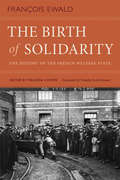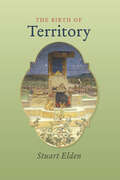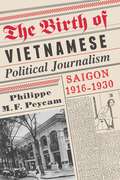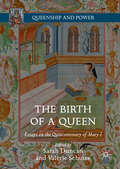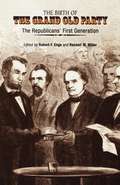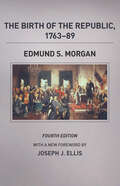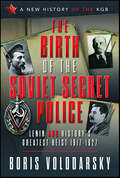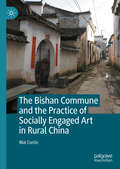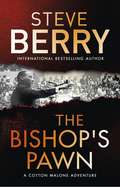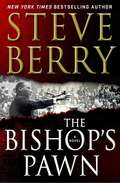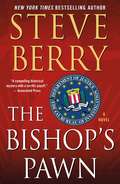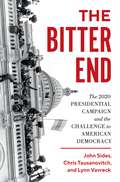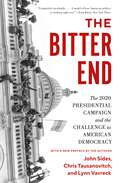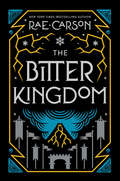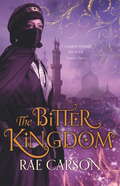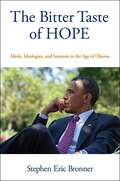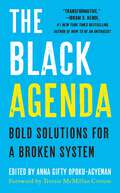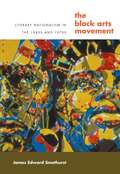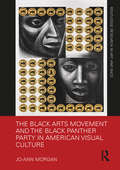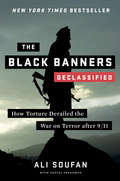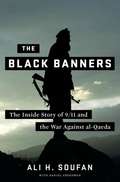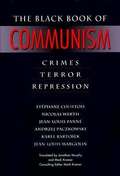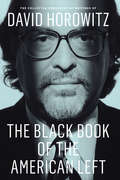- Table View
- List View
The Birth of Solidarity: The History of the French Welfare State
by François EwaldFrançois Ewald's landmark The Birth of Solidarity—first published in French in 1986, revised in 1996, with the revised edition appearing here in English for the first time—is one of the most important historical and philosophical studies of the rise of the welfare state. Theorizing the origins of social insurance, Ewald shows how the growing problem of industrial accidents in France throughout the nineteenth century tested the limits of classical liberalism and its notions of individual responsibility. As workers and capitalists confronted each other over the problem of workplace accidents, they transformed the older practice of commercial insurance into an instrument of state intervention, thereby creating an entirely new conception of law, the state, and social solidarity. What emerged was a new system of social insurance guaranteed by the state. The Birth of Solidarity is a classic work of social and political theory that will appeal to all those interested in labor power, the making and dismantling of the welfare state, and Foucauldian notions of governmentality, security, risk, and the limits of liberalism.
The Birth of Territory
by Stuart EldenPolitical theory professor Stuart Elden explores the history of land ownership and control from the ancient to the modern world in The Birth of Territory.Territory is one of the central political concepts of the modern world and, indeed, functions as the primary way the world is divided and controlled politically. Yet territory has not received the critical attention afforded to other crucial concepts such as sovereignty, rights, and justice. While territory continues to matter politically, and territorial disputes and arrangements are studied in detail, the concept of territory itself is often neglected today. Where did the idea of exclusive ownership of a portion of the earth’s surface come from, and what kinds of complexities are hidden behind that seemingly straightforward definition? The Birth of Territory provides a detailed account of the emergence of territory within Western political thought. Looking at ancient, medieval, Renaissance, and early modern thought, Stuart Elden examines the evolution of the concept of territory from ancient Greece to the seventeenth century to determine how we arrived at our contemporary understanding. Elden addresses a range of historical, political, and literary texts and practices, as well as a number of key players—historians, poets, philosophers, theologians, and secular political theorists—and in doing so sheds new light on the way the world came to be ordered and how the earth’s surface is divided, controlled, and administered.“The Birth of Territory is an outstanding scholarly achievement . . . a book that already promises to become a ‘classic’ in geography, together with very few others published in the past decades.” —Political Geography“An impressive feat of erudition.” —American Historical Review
The Birth of Vietnamese Political Journalism: Saigon, 1916-1930
by Philippe PeycamPhilippe M. F. Peycam completes the first ever English-language study of Vietnam's emerging political press and its resistance to colonialism. Published in the decade that preceded the Communist Party's founding, this journalistic phenomenon established a space for public, political contestation that fundamentally changed Vietnamese attitudes and the outlook of Southeast Asia. Peycam directly links Saigon's colonial urbanization to the creation of new modes of individual and collective political agency. To better justify their presence, French colonialists implemented a peculiar brand of republican imperialism to encourage the development of a highly controlled print capitalism. Yet the Vietnamese made clever use of this new form of political expression, subverting colonial discourse and putting French rulers on the defensive, while simultaneously stoking Vietnamese aspirations for autonomy. Peycam specifically considers the work of Western-educated Vietnamese journalists who, in their legal writings, called attention to the politics of French rule.Peycam rejects the notion that Communist and nationalist ideologies changed the minds of "alienated" Vietnamese during this period. Rather, he credits colonial urban modernity with shaping the Vietnamese activist-journalist and the role of the French, even at their most coercive, along with the modern public Vietnamese intellectual and his responsibility toward the group. Countering common research on anticolonial nationalism and its assumptions of ethno-cultural homogeneity, Peycam follows the merging of French republican and anarchist traditions with neo-Confucian Vietnamese behavior, giving rise to modern Vietnamese public activism, its autonomy, and its contradictory aspirations. Interweaving biography with archival newspaper and French police sources, he writes from within these journalists' changing political consciousness and their shifting perception of social roles.
The Birth of a Queen
by Sarah Duncan Valerie SchutteMarking the 500th year anniversary of the birth ofQueen Mary I in 1516, this book both commemorates her rule and rehabilitatesand redefines her image and reign as England's first queen regnant. In thisbroad collection of essays, leading historians of queenship (or monarchy)explore aspects of Mary's life from birth to reign to death and culturalafterlife, giving consideration to the struggles she faced both before andafter her accession, and celebrating Mary as a queen in her own right.
The Birth of the Grand Old Party
by James M. Mcpherson Randall M. Miller Robert F. EngsThe period from 1850 to 1876 was the most transformative era in American history. During the course of this tumultuous quarter century Americans fought a bloody civil war, tried to settle the issue of state versus central government power, recognized the dominance of the new industrial economy over the older agricultural one, and ended slavery, long the shame of the nation. At the same time, a major political realignment occurred with the collapse of the "second American party system" and the emergence of a new party, the Republicans.But the defeat of slavery--the chief catalyst for the birth of the Republican party--was at best a limited success. The Constitution had been rewritten to abolish slavery and guarantee equal protection under the law, but social equality for African Americans and expanding freedom for others remained elusive throughout the nation. For these triumphs and enduring tragedy, the Republican party, which became in time and memory the party of Abraham Lincoln, bore primary responsibility.This collection of six original essays by some of America's most distinguished historians of the Civil War era examines the origins and evolution of the Republican party over the course of its first generation. The essays consider the party in terms of its identity, interests, ideology, images, and individuals, always with an eye to the ways the Republican party influenced midnineteenth-century concerns over national character, political power, race, and civil rights.The authors collectively extend their inquiries from the 1850s through the 1870s to understand the processes whereby the second American party system broke down, a new party and politics emerged, the Civil War came, and a new political and social order developed. They especially consider how ideas about freedom in the 1850s coalesced during war and Reconstruction to produce both an expanded call for political and civil rights for the ex-slaves and a concern over expanded federal involvement in the protection of those rights. By observing the transformation of a sectional party born in the 1850s into the "Grand Old Party" by the 1870s, the authors demonstrate that no modern political party, even the one that claims descent from Lincoln, has surpassed the accomplishments of the first generation of Republicans.Contributors--Jean H. Baker, Professor of History at Goucher College, Maryland, is author of Mary Todd Lincoln: A Biography.Eric Foner, DeWitt Clinton Professor of History at Columbia University, is author of Reconstruction: America's Unfinished Revolution, 1863-1877, winner of the Bancroft Prize.Michael F. Holt, Langbourne M. Williams Professor of American History at the University of Virginia, is author of The Rise and Fall of the American Whig Party: Jacksonian Politics and the Onset of the Civil War.James M. McPherson, Professor of History at Princeton University, is author of Battle Cry of Freedom: The Civil War Era, winner of the Pulitzer Prize in history.Mark E. Neely, Jr., McCabe-Greer Professor in the American Civil War Era at Pennsylvania State University, is author of The Fate of Liberty: Abraham Lincoln and Civil Liberties, winner of the Pulitzer Prize in history.Phillip Shaw Paludan, Naomi Lynn Professor of Lincoln Studies at the University of Illinois at Springfield, is author of The Presidency of Abraham Lincoln, winner of the Lincoln Prize.Brooks D. Simpson, Professor of History at Arizona State University, is author of Ulysses S. Grant: Triumph over Adversity, 1822-1865.Published in cooperation with The Library Company of Philadelphia.
The Birth of the Palestinian Refugee Problem Revisited
by Benny MorrisBenny Morris' The Birth of the Palestinian Refugee Problem was published in 1988. Its startling revelations about how and why 700,000 Palestinians left their homes and became refugees during the Arab-Israeli war in 1948 undermined traditional interpretations as to whether they left voluntarily or were expelled as part of a systematic plan. This 2004 book represents a revised edition of the earlier work, compiled on the basis of newly-opened Israeli military archives. While the focus remains the 1948 war and the analysis of the Palestinian exodus, the new material contains more information about what happened in Jerusalem, Jaffa and Haifa, and how events there led to the collapse of Palestinian urban society. It also sheds light on the battles and atrocities that resulted in the disintegration of rural communities. The story is a harrowing one. The refugees now number four million and their existence remains a major obstacle to peace.
The Birth of the Republic, 1763–89 (The Chicago History of American Civilization)
by Edmund S. Morgan“No better brief chronological introduction to the period can be found.” —Wilson QuarterlyIn The Birth of the Republic, 1763–89, Edmund S. Morgan shows how the challenge of British taxation started Americans on a search for constitutional principles to protect their freedom, and eventually led to the Revolution. By demonstrating that the founding fathers’ political philosophy was not grounded in theory, but rather grew out of their own immediate needs, Morgan paints a vivid portrait of how the founders’ own experiences shaped their passionate convictions, and these in turn were incorporated into the Constitution and other governmental documents. The Birth of the Republic is the classic account of the beginnings of the American government, and in this fourth edition the original text is supplemented with a new foreword by Joseph J. Ellis and a historiographic essay by Rosemarie Zagarri.“The Birth of the Republic is particularly to be praised because of the sensible and judicious views offered by Morgan. He is unfair neither to Britain nor to the colonies.”—American Historical Review
The Birth of the Soviet Secret Police: Lenin and History's Greatest Heist, 1917–1927 (A\new History Of The Kgb Ser.)
by Boris VolodarskyThis book is new in every aspect and not only because neither the official history nor an unofficial history of the KGB, and its many predecessors and successors, exists in any language. In this volume, the author deals with the origins of the KGB from the Tsarist Okhrana (the first Russians secret political police) to the OGPU, Joint State Political Directorate, one of the KGB predecessors between 1923 and 1934. Based on documents from the Russian archives, the author clearly demonstrates that the Cheka and GPU/OPGU were initially created to defend the revolution and not for espionage. The Okhrana operated in both the Russian Empire and abroad against the revolutionaries and most of its operations, presented in this book, are little known. The same is the case with regards to the period after the Cheka was established in December 1917 until ten years later when Trotsky was expelled from the Communist Party and exiled, and Stalin rose to power. For the long period after the Revolution and up to the Second World War (and, indeed, beyond until the death of Stalin) the Cheka’s main weapon was terror to create a general climate of fear in a population. In the book, the work of the Cheka and its successors against the enemies of the revolution is paralleled with British and American operations against the Soviets inside and outside of Russia. For the first time the creation of the Communist International (Comintern) is shown as an alternative Soviet espionage organization for wide-scale foreign propaganda and subversion operations based on the new revelations from the Soviet archives Here, the early Soviet intelligence operations in several countries are presented and analyzed for the first time, as are raids on the Soviet missions abroad. The Bolshevik smuggling of the Russian imperial treasures is shown based on the latest available archival sources with misinterpretations and sometimes false interpretations in existing literature revised. After the Bolshevik revolution, Mansfield Smith-Cumming, the first chief of SIS, undertook to set up ‘an entirely new Secret Service organization in Russia’. During those first ten years, events would develop as a non-stop struggle between British intelligence, within Russia and abroad, and the Cheka, later GPU/OGPU. Before several show ‘spy trials’ in 1927, British intelligence networks successfully operated in Russia later moving to the Baltic capitals, Finland and Sweden while young Soviet intelligence officers moved to London, Paris, Berlin and Constantinople. Many of those operations, from both sides, are presented in the book for the first time in this ground-breaking study of the dark world of the KGB
The Bishan Commune and the Practice of Socially Engaged Art in Rural China: The Bishan Commune And The Practice Of Socially Engaged Art In Rural China
by Mai CorlinThis book is concerned with socially engaged art projects in the Chinese countryside, with the artists and intellectuals who are involved, the villagers they meet and the local authorities with whom they negotiate. In recent years an increasing number of urban artists have turned towards the countryside in an attempt to revive rural areas perceived to be in a crisis. The vantage point of this book is the Bishan Commune. In 2010, Ou Ning drafted a notebook entitled Bishan Commune: How to Start Your Own Utopia. The notebook presents a utopian ideal of life based on anarchist Peter Kropotkin’s idea of mutual aid. In 2011 the Commune was established in Bishan Village in Anhui Province. The main questions of this book thus revolve around how an anarchist, utopian community unfolds to the backdrop of the political, social and historical landscape of rural China, or more directly: How do you start your own utopia in the Chinese countryside?
The Bishop's Pawn (Cotton Malone #13)
by Steve BerryThe first case of New York Times bestseller Steve Berry's iconic hero, Cotton Malone.History notes that the ugly feud between J. Edgar Hoover and Martin Luther King, Jr., marked by years of illegal surveillance and the accumulation of secret files, ended on April 4, 1968 when King was assassinated by James Earl Ray. But that may not have been the case.Now, fifty years later, former Justice Department agent Cotton Malone must reckon with what really happened on that fateful day in Memphis.It all turns on an incident from eighteen years ago, when Malone, a young Navy lawyer trying hard not to live up to his maverick reputation, is asked by Stephanie Nelle at the Justice Department to help with an investigation. He soon discovers that the Department and the FBI are at war over a hugely valuable rare coin - and a cache of secret files containing explosive revelations about the King assassination, information that could ruin innocent lives and threaten the legacy of the civil rights movement's greatest martyr.Malone's decision to see his first case through to the end - from the clear waters of the Dry Tortugas to the halls of power in Washington D.C. itself - not only changes his own life, but the course of history.
The Bishop's Pawn (Cotton Malone #13)
by Steve BerryThis audiobook is an expanded, annotated 'writer's cut' edition of The Bishop's Pawn, including fascinating behind-the-scenes commentary read by author Steve Berry. On the 50th anniversary of the death of Martin Luther King, comes the explosive new thriller from international bestseller Steve Berry that sees Cotton Malone return to his very first case.History notes that the ugly feud between J. Edgar Hoover and Martin Luther King, Jr., marked by years of illegal surveillance and the accumulation of secret files, ended on April 4, 1968 when King was assassinated by James Earl Ray. But that may not have been the case.Now, fifty years later, former Justice Department agent Cotton Malone must reckon with what really happened on that fateful day in Memphis.It all turns on an incident from eighteen years ago, when Malone, a young Navy lawyer trying hard not to live up to his maverick reputation, is asked by Stephanie Nelle at the Justice Department to help with an investigation. He soon discovers that the Department and the FBI are at war over a hugely valuable rare coin - and a cache of secret files containing explosive revelations about the King assassination, information that could ruin innocent lives and threaten the legacy of the civil rights movement's greatest martyr.Malone's decision to see his first case through to the end - from the clear waters of the Dry Tortugas to the halls of power in Washington D.C. itself - not only changes his own life, but the course of history.(P)2018 Macmillan Audio
The Bishop's Pawn (Cotton Malone Series #13)
by Steve Berry<P>History notes that the ugly feud between J. Edgar Hoover and Martin Luther King, Jr., marked by years of illegal surveillance and the accumulation of secret files, ended on April 4, 1968 when King was assassinated by James Earl Ray. But that may not have been the case. <P>Now, fifty years later, former Justice Department agent, Cotton Malone, must reckon with the truth of what really happened that fateful day in Memphis. <P>It all turns on an incident from eighteen years ago, when Malone, as a young Navy lawyer, is trying hard not to live up to his burgeoning reputation as a maverick. When Stephanie Nelle, a high-level Justice Department lawyer, enlists him to help with an investigation, he jumps at the opportunity. <P>But he soon discovers that two opposing forces—the Justice Department and the FBI—are at war over a rare coin and a cadre of secret files containing explosive revelations about the King assassination, information that could ruin innocent lives and threaten the legacy of the civil rights movement’s greatest martyr. <P>Malone’s decision to see it through to the end —— from the raucous bars of Mexico, to the clear waters of the Dry Tortugas, and ultimately into the halls of power within Washington D.C. itself —— not only changes his own life, but the course of history.
The Bishop's Pawn: A Novel (Cotton Malone #13)
by Steve BerryThe first case of New York Times bestseller Steve Berry’s iconic hero, Cotton Malone. <P><P>History notes that the ugly feud between J. Edgar Hoover and Martin Luther King, Jr., marked by years of illegal surveillance and the accumulation of secret files, ended on April 4, 1968 when King was assassinated by James Earl Ray. But that may not have been the case. <P>Now, fifty years later, former Justice Department agent, Cotton Malone, must reckon with the truth of what really happened that fateful day in Memphis.It all turns on an incident from eighteen years ago, when Malone, as a young Navy lawyer, is trying hard not to live up to his burgeoning reputation as a maverick. <P>When Stephanie Nelle, a high-level Justice Department lawyer, enlists him to help with an investigation, he jumps at the opportunity. But he soon discovers that two opposing forces—the Justice Department and the FBI—are at war over a rare coin and a cadre of secret files containing explosive revelations about the King assassination, information that could ruin innocent lives and threaten the legacy of the civil rights movement’s greatest martyr. <P>Malone’s decision to see it through to the end —— from the raucous bars of Mexico, to the clear waters of the Dry Tortugas, and ultimately into the halls of power within Washington D.C. itself —— not only changes his own life, but the course of history. <P>Steve Berry always mines the lost riches of history —— in The Bishop's Pawn he imagines a gripping, provocative thriller about an American icon. <P><b>A New York Times Bestseller</b>
The Bitter End: The 2020 Presidential Campaign and the Challenge to American Democracy
by Lynn Vavreck John Sides Chris TausanovitchWhat an intensely divisive election portends for American politicsThe year 2020 was a tumultuous time in American politics. It brought a global pandemic, protests for racial justice, and a razor-thin presidential election outcome. It culminated in an attack on the U.S. Capitol that attempted to deny Joe Biden’s victory. The Bitter End explores the long-term trends and short-term shocks that shaped this dramatic year and what these changes could mean for the future.John Sides, Chris Tausanovitch, and Lynn Vavreck demonstrate that Trump’s presidency intensified the partisan politics of the previous decades and the identity politics of the 2016 election. Presidential elections have become calcified, with less chance of big swings in either party’s favor. Republicans remained loyal to Trump and kept the election close, despite Trump’s many scandals, a recession, and the pandemic. But in a narrowly divided electorate even small changes can have big consequences. The pandemic was a case in point: when Trump pushed to reopen the country even as infections mounted, support for Biden increased. The authors explain that, paradoxically, even as Biden’s win came at a time of heightened party loyalty, there remained room for shifts that shaped the election’s outcome. Ultimately, the events of 2020 showed that instead of the country coming together to face national challenges—the pandemic, George Floyd’s murder, and the Capitol riot—these challenges only reinforced divisions.Expertly chronicling the tensions of an election that came to an explosive finish, The Bitter End presents a detailed account of a year of crises and the dangerous direction in which the country is headed.
The Bitter End: The 2020 Presidential Campaign and the Challenge to American Democracy
by Lynn Vavreck John Sides Chris TausanovitchWhat an intensely divisive election portends for American politicsThe year 2020 was a tumultuous time in American politics. It brought a global pandemic, protests for racial justice, and a razor-thin presidential election outcome. It culminated in an attack on the U.S. Capitol that attempted to deny Joe Biden’s victory. The Bitter End explores the long-term trends and short-term shocks that shaped this dramatic year and what these changes could mean for the future.John Sides, Chris Tausanovitch, and Lynn Vavreck demonstrate that Trump’s presidency intensified the partisan politics of the previous decades and the identity politics of the 2016 election. Presidential elections have become calcified, with less chance of big swings in either party’s favor. Republicans remained loyal to Trump and kept the election close, despite Trump’s many scandals, a recession, and the pandemic. But in a narrowly divided electorate even small changes can have big consequences. The pandemic was a case in point: when Trump pushed to reopen the country even as infections mounted, support for Biden increased. The authors explain that, paradoxically, even as Biden’s win came at a time of heightened party loyalty, there remained room for shifts that shaped the election’s outcome. Ultimately, the events of 2020 showed that instead of the country coming together to face national challenges—the pandemic, George Floyd’s murder, and the Capitol riot—these challenges only reinforced divisions.Expertly chronicling the tensions of an election that came to an explosive finish, The Bitter End presents a detailed account of a year of crises and the dangerous direction in which the country is headed.
The Bitter Kingdom (Girl of Fire and Thorns #3)
by Rae CarsonThe third book in Rae Carsons award-winning The Girl of Fire and Thorns fantasy trilogy. Elisa, the seventeen-year-old sorcerer-queen, will travel into an unknown enemys realm to win back her true love, save her kingdom, and uncover the final secrets of her destiny. Veronica Roth called The Girl of Fire and Thorns "intense, unique . . . definitely recommended. "Perfect for fans of Tamora Pierce and George R. R. Martins style of sweeping and deeply satisfying epic fantasy, the third and final book in the trilogy takes the young queen on a journey more dangerous than any she has faced before. Elisa will stand before the gate of the enemy. And she must rise up as champion--even to those who have hated her--or her kingdom will fall. Full of sorcery, adventure, sizzling romance, and secrets that challenge everything she believes, this is a bold and powerful conclusion to an extraordinary trilogy. As USAToday. com proclaimed, "Rae Carson has proved shes a master and has shaken up the YA genre. "
The Bitter Kingdom: The Girl Of Fire And Thorns, The Shadow Cats, The Crown Of Embers, The Shattered Mountain, The King's Guard, The Bitter Kingdom (Girl Of Fire And Thorns Ser. #3)
by Rae CarsonIn the final volume of Carson’s trilogy, the seventeen-year-old sorcerer-queen will travel into the unknown realm of the enemy to win back her true love, save her country, and uncover the final secrets of her destiny.
The Bitter Taste of Hope: Ideals, Ideologies, and Interests in the Age of Obama (SUNY series in New Political Science)
by Stephen Eric BronnerPresident Barack Obama was elected to office on a wave of hope. With his tenure as President of the United States now concluded it is time to take stock of his record at home and abroad. The Bitter Taste of Hope is a collection of essays that critically evaluate America's domestic landscape on the one hand, particularly new social movements, and the nation's foreign policy, particularly in the Middle East, on the other. Stephen Eric Bronner engages a wide-ranging set of political and ideological conflicts that defined the "Age of Obama," especially the most pressing international concerns that have developed in accord with an increasingly globalized world. Bronner illuminates not only well-known events like the American involvement in Afghanistan and Iraq, the plight of the Palestinians, and the Arab Spring but also matters about which the general public knows little such as the national hopes of the Circassians, the complexities of Sudan, and the pitiful existence endured by the Coptic Christians of Cairo. Clearly written, lively in its style, interdisciplinary in conception and timely in its message, The Bitter Taste of Hope will undoubtedly prove required reading for activists and academics alike.
The Black Agenda: Bold Solutions for a Broken System
by Anna Gifty Opoku-Agyeman"The Black Agenda mobilizes top Black experts from across the country to share transformative perspectives on how to deploy anti-racist ideas and policies into everything from climate policy to criminal justice to healthcare. This book will challenge what you think is possible by igniting long overdue conversations around how to enact lasting and meaningful change rooted in racial justice." —Ibram X. Kendi, #1 New York Times bestselling author of How to Be an Antiracist and Stamped From the BeginningFrom ongoing reports of police brutality to the disproportionate impact COVID-19 has had on Black Americans, 2020 brought a renewed awareness to the deep-rootedness of racism and white supremacy in every facet of American life. Edited by Anna Gifty Opoku-Agyeman, The Black Agenda is the first book of its kind—a bold and urgent move towards social justice through a profound collection of essays featuring Black scholars and experts across economics, education, health, climate, and technology. It speaks to the question "What's next for America?" on the subjects of policy-making, mental health, artificial intelligence, climate movement, the future of work, the LGBTQ community, the criminal legal system, and much more. Essayists including Dr. Sandy Darity, Dr. Hedwig Lee, Mary Heglar, and Janelle Jones present groundbreaking ideas ranging from Black maternal and infant health to reparations to AI bias to inclusive economic policy, with the potential to uplift and heal not only Black America, but the entire country.
The Black Arts Movement
by James SmethurstEmerging from a matrix of Old Left, black nationalist, and bohemian ideologies and institutions, African American artists and intellectuals in the 1960s coalesced to form the Black Arts Movement, the cultural wing of the Black Power Movement. In this comprehensive analysis, James Smethurst examines the formation of the Black Arts Movement and demonstrates how it deeply influenced the production and reception of literature and art in the United States through its negotiations of the ideological climate of the Cold War, decolonization, and the civil rights movement.Taking a regional approach, Smethurst examines local expressions of the nascent Black Arts Movement, a movement distinctive in its geographical reach and diversity, while always keeping the frame of the larger movement in view. The Black Arts Movement, he argues, fundamentally changed American attitudes about the relationship between popular culture and "high" art and dramatically transformed the landscape of public funding for the arts.
The Black Arts Movement and the Black Panther Party in American Visual Culture (Routledge Research in Art and Race)
by Jo-Ann MorganThis book examines a range of visual expressions of Black Power across American art and popular culture from 1965 through 1972. It begins with case studies of artist groups, including Spiral, OBAC and AfriCOBRA, who began questioning Western aesthetic traditions and created work that honored leaders, affirmed African American culture, and embraced an African lineage. Also showcased is an Oakland Museum exhibition of 1968 called "New Perspectives in Black Art," as a way to consider if Black Panther Party activities in the neighborhood might have impacted local artists’ work. The concluding chapters concentrate on the relationship between selected Black Panther Party members and visual culture, focusing on how they were covered by the mainstream press, and how they self-represented to promote Party doctrine and agendas.
The Black Banners: How Torture Derailed The War On Terror After 9/11 (Playaway Adult Nonfiction Ser.)
by Ali SoufanThe definitive account of an FBI special agent’s al-Qaeda story, unredacted for the first time. Widely heralded on publication as a "must-read" (Military Review) and "important window on America’s battle with al-Qaeda" (Washington Post), Ali Soufan’s revelatory account of the war on terror as seen from its front lines changed the way we understand al-Qaeda and how the United States prosecuted the war—and led to hard questions being asked of our leaders. When The Black Banners was published in 2011, significant portions of the text were redacted. After subsequent review by the Central Intelligence Agency, those redactions have been lifted. Their removal corrects the record on how vital intelligence was obtained from al-Qaeda suspects and brings forth important new details on the controversial use of enhanced interrogation techniques (torture) to extract information from terror suspects. For many years, proponents of the use of these techniques have argued that they produced actionable intelligence in the war on terror. This edition of The Black Banners explodes this myth; it shows Soufan at work using guile and intelligent questioning—not force or violence—to extract some of the most important confessions in the war, and it vividly recounts the failures of the government’s torture program. Drawing on Soufan’s experiences as a lead operative for the FBI and declassified government records, The Black Banners (Declassified) documents the intelligence failures that lead to the tragic attacks on New York and Washington, DC, and subsequently how torture derailed the fight against al-Qaeda. With this edition, eighteen years on from the first sanctioned enhanced interrogation technique, the public can finally read the complete story of what happened in their name after the events of 9/11. The Black Banners (Declassified) includes a new foreword from Ali Soufan that addresses the significance of the CIA’s decision to lift the redactions.
The Black Banners: The Inside Story of 9/11 and the War Against Al-qaeda
by Ali H. Soufan Daniel FreedmanSoufan worked as a former special agent for the FBI, and this book is a first-person chronicle of his work in the war against al-Qaeda, especially after the World Trade Center attacks in 2001. He starts before those attacks though, with the formation of the organization itself in the 1990s and the attack on the USS Cole. He spends the chapters after this preliminary account on the 9/11 attacks themselves, high valued detainees, the final missions leading up to Osama bin Laden's capture, and what he calls successes and failures. In particular, he notes the inefficacy of torture and aggressive approaches. Throughout the book he maintains allegiance to the FBI and USA, and opens with a note disclosing that this is an FBI and CIA approved story, which he "would have submitted . . . . for review even if [he] had no legal obligation to do so. " To that end, names and sections of text are occasionally blacked out. There is a co-author, Daniel Freedman, but he is only briefly mentioned in the acknowledgements. There is no index, but there is a glossary of "principal characters" and a basic bibliography.
The Black Book Of Communism: Crimes, Terror, Repression
by Mark Kramer Nicolas Werth Martin Malia Jonathan Murphy Stéphane Courtois Jean-Louis Panné Andrzej Paczkowski Karel Bartosek Jean-Louis MargolinCommunism has been the great story of the twentieth century. Bursting into history from the most unlikely corner of Europe amid the trauma of World War I, in the wake of the cataclysm of 1939-1945 it made a great leap westward to the middle of Germany and an even greater one east¬ward to the China Seas. With this feat, the apogee of its fortunes, it had come to rule a third of mankind and seemed poised to advance indefinitely. For seven decades it haunted world politics, polarizing opinion between those who saw it as the socialist end of history and those who considered it history's most total tyranny.
The Black Book of the American Left
by David HorowitzDavid Horowitz spent the first part of his life in the world of the Communist-progressive left, a politics he inherited from his mother and father, and later in the New Left as one of its founders. When the wreckage he and his comrades had created became clear to him in the mid-1970s, he left. Three decades of second thoughts then made him this movement's principal intellectual antagonist. "For better or worse," as Horowitz writes in the preface to this, the first volume of his collected conservative writings, "I have been condemned to spend the rest of my days attempting to understand how the left pursues the agendas from which I have separated myself, and why."When Horowitz began his odyssey, the left had already escaped the political ghetto to which his parents' generation and his own had been confined. Today, it has become the dominant force in America's academic and media cultures, electing a president and achieving a position from which it can shape America's future. How it achieved its present success and what that success portends are the overarching subjects of Horowitz's conservative writings. Through the unflinching focus of one singularly engaged witness, the identity of a destructive movement that constantly morphs itself in order to conceal its identity and mission becomes disturbingly clear.In Volume I of these writings, "My Life and Times," Horowitz reflects on the years he spent at war with his own country, collaborating with and confronting radical figures like Huey Newton, Tom Hayden and Billy Ayers, as he made his transition from what the writer Paul Berman described as the American left's "most important theorist" to its most determined enemy.
